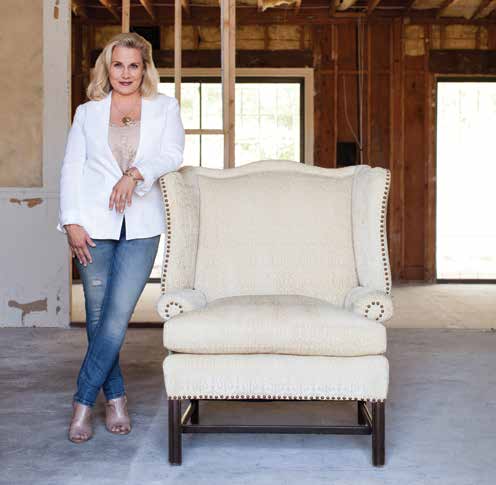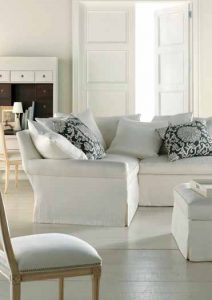Upholstery 101: The Right Stuff!

When I was a freshman in high school, my mother hired an interior designer to redo the furnishings of the ranch house that she and my father had built in the hills above the San Fernando Valley. She decided to do this to surprise my dad who was away for six months on location in Tunisia.
My mother had always handled the furnishings and décor of our homes by herself, and she had done an impressive job, but she had reached a point where what she was trying to achieve was simply out of grasp without the help of a professional. One very specific request she made of her design-er, I remember, was that the upholstery be designed to hold up to her cowboy/stunt-man husband and all of his cowboy/stunt-man friends when they came in from riding, training, or filming—tired, dirty, and in rough denim. Up to that point, my dad had worn out a sofa every 12 months, so my mother was bound and determined that the next sofa would be the one to challenge his reign of destruction, while simultaneously satisfying her desire for a lovely and inviting family room.
The pair of sofas that the designer eventually delivered met and surpassed every expectation and became, for me, the first and best examples of really good upholstery. They also clarified the difference be-tween good upholstery and that which is readily available in stores and catalogs. So, what made these sofas so fabulous? Well, everything, really. The construction, the pro-portions, and the styling were great, but a large part of what made them terrific was tactile—the way they felt when you sat in them. So, when does it make sense to re-upholster a piece of existing furniture? Let’s look at what makes a fine piece of upholstery and the criteria that makes a piece one to toss or one to invest in. For me, it’s first about the general silhouette and frame. Is it timeless and comfortable and will it, if reupholstered, serve the design of the space for which it’s being considered? In the case of my mother’s sofas, the frames were made of solid kiln-dried hardwood with hand tied springs joined to a steel-wire frame, supported by a basket weave of jute webbing strips throughout the deck and back. The silhouette was a classic Hollywood divan, low and tight-backed with a deep seat and an ageless style. The seat cushions were constructed of spring coils wrapped in fabric with a thick down envelope surround. When I sat down on these sofas, they wrapped themselves around me and supported me in a way that I had never felt a piece of upholstery do. Their cost was significant, but they proved to be one of the most worthwhile furnishing investments my parents ever made.

A common assumption is that the choice to reupholster is cost effective as compared with buying new, but this is not always the case. A well-made sofa with great lines or a French bergere chair with wonderful character are certainly worthy candidates, but re-upholstery is an investment. The typical sofa requires about 21 yards of fabric, and upholstery-weight fabric can range between $90 to $150 per yard. I generally expect the labor to reupholster an average-sized sofa to cost around $1,000. A typical lounge chair re-quires about nine yards of fabric and will cost around $500 in labor. The reality is that reupholstering can sometimes cost more than a new piece, but if the bones of the piece are worthy, then the investment is worthwhile.
The important takeaway when it comes to reupholstering an existing piece is that the true value lies beneath the surface. In today’s online marketplace, upholstery can be one of the most challenging categories to vet. I counsel clients to learn what’s on the inside of what they’re purchasing and to put the bulk of the dollars they spend “underneath the hood,” especially if the piece is to receive everyday use. We recently had clients who purchased a massive leather sectional from a very popular catalog brand. Nine months in, the seat and back cushions had sagged to half of their previous height. It felt like their sofa was stuffed with smoke and mirrors! We actually see this quite often with catalog and online upholstery.

My mother’s sofas, on the other hand? It took 18 years of everyday use before those sofas needed to be reupholstered, and I went on to recover them twice for use in two different homes, after she passed them down to me. The lesson is, as always, that you get what you pay for. Don’t be bedazzled by surface sparkle. Do your homework and try to invest in upholstery that is as fine on the inside as it is on the outside. I promise that if you do, you will never be sorry!
Until next time, here’s to creating your own Noble Spaces!
Tammy Randall Wood, ASID is the founder and principal of Interior Archaeology. She has designed an extensive array of projects coast to coast – from seaside cottages on Martha’s Vineyard, metropolitan penthouses and formal Beltway manors to cultivated West Coast compounds. Her firm brings a fresh approach to tailored interiors.
Tweet Tammy your upholstery story @IArchaeology
Tammy Randall Wood, ASID
INTERIOR ARCHAEOLOGY
818.991.0365
InteriorArchaeology.com
facebook.com/InteriorArchaeology
instagram.com/interiorarchaeology



